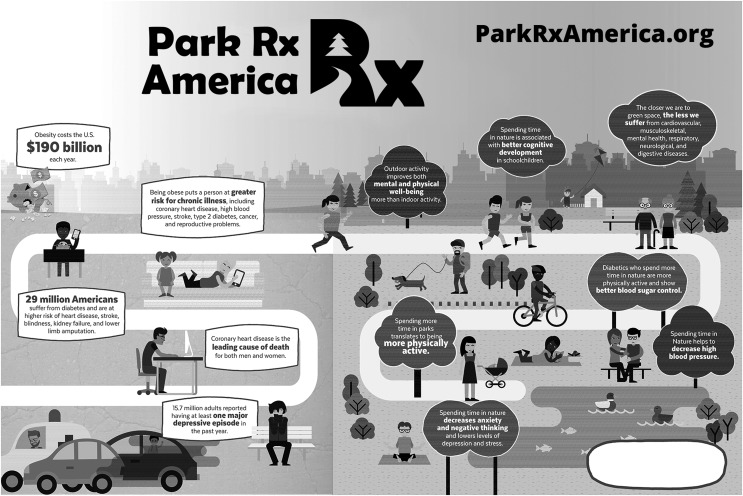Transition to green. Courtesy of Park Rx America, National Environmental Education Foundation, National Park Service. Printed with permission.
As a pediatrician and a public health professional, we are committed to prevention, and we applaud Buller et al.’s (p. 1869) interest in finding evidence to support interventions aimed at reducing skin cancer. As advocates for park prescriptions and other nature-based prescriptions, we are deeply concerned about another epidemic: nature deficit.
NATURE DEFICIT
Nature deficit, or a lack of sufficient time outdoors in a natural setting, contributes to poor outcomes of chronic diseases, including obesity, diabetes, hypertension, depression, anxiety, attention deficit hyperactivity disorder (ADHD), vitamin D deficiency, decreased happiness and well-being, and cardiovascular and respiratory illness. The exact causative mechanism between nature deficit and chronic disease has not yet been identified; however, correlational research has shown that time spent in natural areas can provide measurable health benefits such as improved cardiovascular health, decreased levels of stress, improved self-esteem, and elevated mood. Spending time in nature is linked with decreased anxiety, rumination, and negative affect, as well as an increase in happiness and overall well-being.1
Outdoor experiences create opportunities to generate human attachment to nature, which leads to a sense of place and belonging, which ultimately fosters environmental stewardship. Trees and other nature-based elements increase aesthetic beauty and provide mental, physical, and emotional health benefits.2 Nature-based interventions are important tools that can help to improve both human and environmental health.
NATURE-BASED INTERVENTIONS
All interventions to create shade will entail cost and maintenance, and building shade sail (flexible membrane tensioned between several anchor points) is no exception. The use of trees for shade is also not exempt from cost and maintenance. There are, however, a number of advantages that trees have over shade sail. Creating urban tree canopy results in stronger communities, as trees provide an array of positive, health-related contributions. Trees are much more durable, and they can be selected to withstand specific environmental conditions—such as extreme solar exposure, winds, and precipitation—that may cause considerable damage to shade sail. Trees also provide direct shading of buildings and reduce wind speed, resulting in increased energy savings. Trees have been found to reduce people’s exposure to solar ultraviolet (UV) radiation, which can cause skin cancer.3 Trees also provide a respiratory advantage over shade sails in their absorption of gaseous pollutants, such as ozone, nitrogen dioxide, and sulfur dioxide, and particulate matter such as dust, ash, and smoke. Planting trees that are native or adapted to appropriate ecosystems, fast growing, low maintenance, pollution resilient, and canopy and shade producing, should be considered as a nature-based alternative to building shade sails.
BUILDING UP THE URBAN TREE CANOPY
The paucity of tree canopy in urban areas, where two thirds of our planet’s population will reside by 2050 (http://wcr.unhabitat.org/wp-content/uploads/2017/02/WCR-2016_-Abridged-version-1.pdf), may pose a significant public health concern in our immediate future. Trees have many advantages over shade sails as an intervention to prevent skin cancer, and they should be considered as a nature-based alternative. With the medical profession’s recent interest in prescribing parks to prevent and treat chronic disease through initiatives like Park Rx America, and the potential to increase time spent outdoors, there is no better time for medical professionals to partner with arboreal experts. Together, we can build safe, health-promoting environments to improve the health of humans and of the nature around us.
Footnotes
REFERENCES
- 1.Bratman GN, Daily GC, Levy BJ, Gross JJ. The benefits of nature experience: improved affect and cognition. Landsc Urban Plan. 2015;138:41–50. [Google Scholar]
- 2.Wolf KL, Krueger S, Flora K. Healing & therapy. Green Cities: Good Health. 2014. Available at: https://depts.washington.edu/hhwb/Thm_Healing.html Accessed October 6, 2017.
- 3.Grant RH, Heisler GM, Gao W. Estimation of pedestrian level UV exposure under trees. Photochem Photobiol. 2002;75(4):369–376. doi: 10.1562/0031-8655(2002)075<0369:eoplue>2.0.co;2. [DOI] [PubMed] [Google Scholar]



